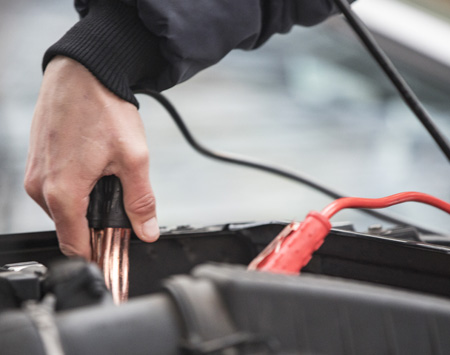Whether it's an interior light that stayed on all night or simply a cold winter morning, a dead car battery can happen to anyone. If you find yourself in a situation where you need to jump start your car, Batteries Plus is here to help. Follow this simple guide to learn how to hook up jumper cables for a safe and easy way to start your car.
Safety Precautions
The most important thing when handling car batteries is to pay attention to safety. Read your car owner's manual before trying any maintenance yourself, and remember a few important safety considerations before jump starting your car:
- Never jump start a damaged battery - if you see any warning signs like leaks, cracks, or corrosion, avoid touching your car battery or attempting to jump start it.
- Never jump start dry or frozen batteries.
- Never touch your jump clips together - when the jumper cables are connected, touching the clips creates a risk of shock, so the best practice is to avoid touching them together at any time.
What You’ll Need
Now that you're confident in your safety precautions, it's time to learn how to jump start a car. Before you can get started, there are a few things you'll need:
- Jumper Cables: It's a good idea to keep these in your car so that you're prepared for any emergency.
- A Power Source: This can be either a portable charger or another car. If you're connecting to another car, make sure that it's one with the same voltage as your battery and is not running low on power.
How to Use Jumper Cables
Begin by familiarizing yourself with the different parts of your jumper cables. The two alligator clips will be different colors, usually red and black on a standard set. The red clip is the positive end, and the black clip is the negative end.
Knowing Your Car Battery
Every car battery has two terminals, which you'll use to connect your jumper cables. These terminals should be clearly marked with a positive (POS or +) and negative (NEG or -) sign.
Steps for Jump Starting Your Car
- Position your vehicle: If you're jump starting from another car, the easiest positions are nose-to-nose or side by side. Turn off the ignition in both cars.
- Connect the cables: Open the hood of your car and locate your battery. Connect the jumper cables as follows:
- Red to positive on the donor battery
- Red to positive on the dead battery
- Black to negative on the donor battery
- Black to an unpainted metal surface that is NOT the battery on the dead car. This can be an unpainted metal surface under the hood and is better if it is not too close to the battery.
- Start the donor car: Let it idle for a few minutes so that it can charge the dead battery.
- Start the dead car: If you want to check that you have enough power, turn on an interior light first. If this works, you likely have enough power to start your vehicle.
After Jump Starting a Car
Once your car is started, unclip the jumper cables in the reverse order of how you connected them, beginning with the black clip that was attached to metal. Once all your cables are disconnected, keep your vehicle running for at least 20 minutes to avoid having to jump start it again.
If the Jump Start Fails
If you're still having trouble starting your car, check all the cable connections and let the donor car run a bit longer. If you still can't start your car after several attempts, it might be time to change your car battery.
While knowing how to jump a battery is always helpful, minimize the amount of times you have to jump start your car by choosing the best car battery. Drop by your local Batteries Plus Bulbs location for advice and helpful tips on finding car and truck batteries with long and durable lifespans.

